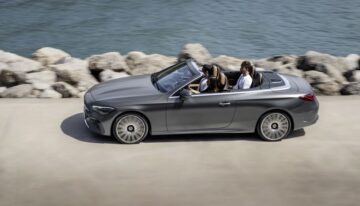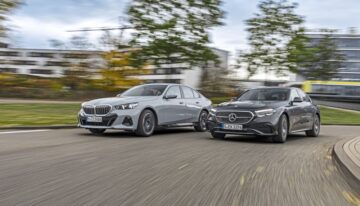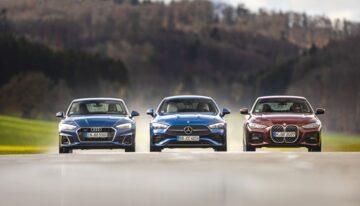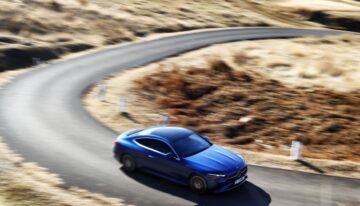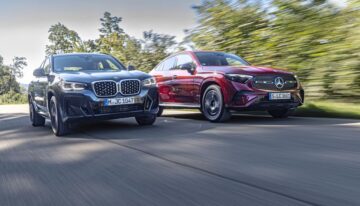Following the unveiling of the electric version of the Mercedes G-Class, the Mercedes off-roader is available in four versions: a mild hybrid diesel, a mild hybrid petrol, the top AMG version with a V8 petrol engine, also with a mild hybrid, and an electric. Which version is more suitable?
After the facelift, Mercedes dropped the V8 engine from the G 500 and replaced it with a 3-liter inline 6-cylinder engine developing 449 PS and 560 Nm, 27 PS more and 50 Nm less than the old V8. The only V8-powered G-Class remains the top-of-the-line AMG G 63, equipped with the 585 PS and 850 Nm 4-litre twin-turbo V8 engine. The G 450 d also replaced the G 400 d, and under the bonnet works the latest evolution of the inline 6-cylinder turbodiesel engine, developing 367 PS and 750 Nm, with 37 PS and 50 Nm more than before.
At the Beijing Motor Show, Mercedes also presented the electric version of the Mercedes G 580 EQ, which is equipped with four motors totaling 588 PS and 1,164 Nm.
Which version of the G-Class is best suited?
The electric version G 580 EQ is the most powerful, with 3 PS and 314 Nm more than the AMG G 63. Also, the G 580 EQ has a better approach and departure angle than the G 500 and G 450 d (32 degrees, respectively 30.7 degrees compared to 31, 30 degrees), while the brakeover angle is better on the G 450 d and G 500 (26 degrees compared to 20.3 degrees). The electric version also has a ground clearance of 250 mm, 9 mm higher than on the G 450 d and G 500, and can pass through a fording depth of 850 mm compared to 700 mm on conventional engine models. Mercedes doesn’t disclose the angles and ground clearance on the AMG G 63, but they are certainly lower than on the G 500 and G 450 d.
G 580 EQ is 25 shorter than the combustion engine versions and 445 kg heavier than the AMG G 63
The Mercedes G 580 EQ is almost 25 cm shorter than the models with combustion engines, although the 2,890 mm wheelbase is identical. With the four engines each located on one wheel, the front end is slightly shorter. However, the boot volume has not suffered due to the decrease in overall length and is identical (454 liters) on all models.
There are significant differences in weight between the four versions. With a 116 kWh battery protected by a 57.6 kg composite shield, the Mercedes G 580 EQ has a curb weight of over 3 tonnes, 3,085 kg to be precise, so the payload of the electric version is the lowest, at only 415 kg. The G 500 is the lightest at 2,485 kg, while the diesel G 450 d is 70 kg heavier. The AMG version is 85 kg heavier than the G 450 d, while the G 580 EQ weighs 445 kg more than the AMG G 63!
In terms of dynamic performance, the G 580 EQ is not the fastest despite having the most power and torque. The high weight penalizes acceleration, and top speed is limited to 180 kph while the AMG G 63 runs at 220 kph and the G 450 d and G 500 at 210 kph. The AMG G 63 accelerates from 0 to 100 kph in 4.3 seconds, 0.4 seconds faster than the G 580 EQ. As expected, if we take WLTP consumption into account, the electric version has the lowest range of only 473 km, which probably doesn’t exceed 350 km in the real world.
AMG G 63 is still the most expensive
And then there’s the price. The Mercedes-AMG G 63 is still the most expensive, at 189,329 euros, while the electric model is 10,000 and 20,000 euros more expensive than the G 500, respectively G 450 d.
| Technical data | G 450 d | G 500 | AMG G 63 | G 580 EQ |
|---|---|---|---|---|
| Propulsion system | mild hybrid 48V | mild hybrid 48V | mild hybrid 48V | full electric |
| Engine | L6, turbodiesel | L6, turbo | V8, bi-turbo | 4 electric motors |
| Displacement (cc) | 2989 | 3,000 | 3,982 | - |
| Max. output/revs (PS/rpm) | 367/4,000 | 449/6,100 | 585/6,000 | 4 x 147 = 588 |
| Max. torque (Nm/rpm) | 750/1,4350-2,800 | 560/1,950-5,500 | 850/1,500-3,500 | 4 x 291 = 1,164 |
| Starter generator | ||||
| Output (PS) | 20 | 20 | 20 | |
| Torque (Nm) | 200 | 200 | 200 | |
| Total output (PS) | 367 | 449 | 585 | 588 |
| Total torque (Nm) | 750 | 560 | 850 | 1164 |
| Transmission | 9 speed, autom. + Low range | 9 speed, autom. + Low range | 9 speed, autom. + Low range | fix gear, Low range |
| Traction | 4wd | 4wd | 4wd | 4wd |
| L x w x h (mm) | 4,825 x 1,931 x 1,971 | 4,825 x 1,931 x 1,971 | 4,873 x 1,984 x 1,971 | 4,624 x 1,931 x 1,986 |
| Wheelbase (mm) | 2,890 | 2,890 | 2,890 | 2890 |
| Curb weight (kg) | 2,555 | 2,485 | 2,640 | 3,085 |
| Boot volume (l) | 454 | 454 | 454 | |
| Battery/tank capacity (kWh/l) | 100 l | 100 l | 100 l | 116 kWh |
| Aproach angle (gr.) | 31 | 31 | 32 | |
| Brakeover angle (gr.) | 26 | 26 | 20.3 | |
| Departure angle (gr.) | 30 | 30 | 30.7 | |
| Ground clearance (mm) | 241 | 241 | 250 | |
| Fording depth (mm) | 700 | 700 | 850 | |
| Performances | ||||
| 0-100 kph (s) | 5.8 | 5.4 | 4.3 | 4.7 |
| Top speed (kph) | 210 | 210 | 220 | 180 |
| Fuel/energy cons. (l/100km, kWh/100 km) | 8.8 | 11.1 | 14.8 | 27.7 |
| CO2 emissions (g/km) | 230 | 252 | 336 | 0 |
| Range (km) | 1,136 | 900 | 676 | 473 |
| Price (euro with VAT) | 122,808 | 132,328 | 189,329 | 142,652 |








